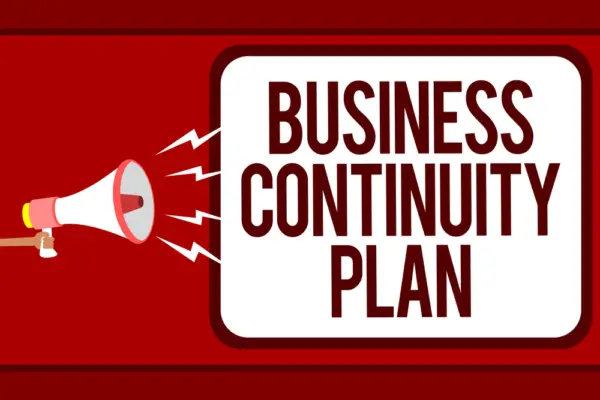A comprehensive Business Continuity Plan (BCP) should contain the following elements:
1. Executive Summary: A brief overview of the BCP’s scope and purpose, easily understood by all stakeholders, including top management.
2. Objectives: Clear articulation of what the BCP aims to achieve to minimize disruption and ensure business resilience.
3. Governance and Roles: Identification of the business continuity team, their roles and responsibilities, and the governance structure overseeing the BCP.
4. Scope: Definition of the BCP’s boundaries, including which departments, locations, and functions it covers.
5. Risk Assessment and Business Impact Analysis (BIA): Detailed analysis of potential risks, their likelihood, and impact on critical business operations, along with a prioritized list of business functions and processes.
6. Preventive Controls: Measures to reduce the probability of disruptions, such as regular maintenance, security measures, and employee training.
7. Response Procedures: Clear instructions on immediate actions during an incident to ensure safety and secure assets.
8. Recovery Strategies: Plans for short-term and long-term recovery, including prioritized steps to restore critical functions and minimize downtime.
9. Communication Plan: Protocols for internal and external communication, including contact lists, notification templates, and communication channels.
10. Recovery Teams: Designation of specific recovery teams, their tasks, and the resources they require.
11. Key Resources: Identify all resources needed for business continuity, including personnel, equipment, technology, information, and financial considerations.
12. Data Backup and Recovery: Detailed plans for data backup, off-site storage, and recovery procedures to protect and restore business information.
13. Alternate Operations: Strategies for alternative business operations if primary facilities, systems, or staff are unavailable.
14. Training and Awareness Programs: Ongoing education and training for staff on their roles in the BCP and how to execute the plan effectively.
15. Testing and Exercise Schedule: Regular testing and exercises to validate the BCP and train staff, including simulations, tabletop exercises, and full-scale drills.
16. Maintenance and Review Schedule: A process for regularly reviewing and updating the BCP to ensure it remains current and effective given changes in the business environment.
17. Appendices: Supporting documents such as contact lists, maps, and equipment.
A business continuity plan (BCP) is a document that outlines how an organization will continue to operate during and after an unexpected disruption, such as a natural disaster, cyber attack, or other crisis.

The plan is designed to minimize the impact of such events by ensuring that critical business functions can continue uninterrupted. A well-designed BCP can help a company quickly recover from a crisis and minimize the potential for long-term damage to the business.
The first step in creating a BCP is understanding the business continuity concept.
Business continuity is the process of ensuring that critical business functions can continue to operate during and after a disruption. This includes identifying the critical processes and systems that are necessary for the business to function, as well as the resources required to support those processes and systems.
Planning and Preparation Once an organization clearly understands what business continuity means, it can begin to develop a BCP.
This involves planning and preparation, which includes identifying potential risks and threats, assessing the impact of those risks and threats on the business, and developing strategies to mitigate those risks and threats.
Key Takeaways
- A business continuity plan (BCP) is a document that outlines how an organization will continue to operate during and after an unexpected disruption.
- Understanding business continuity is the first step in creating a BCP.
- Planning and preparation are critical components of a BCP and include identifying potential risks and threats, assessing their impact, and developing strategies to mitigate them.
Understanding Business Continuity
Definition and Objectives
Business continuity refers to the ability of an organization to continue its operations and provide services to customers in the event of a disruption or disaster.
A business continuity plan (BCP) is a comprehensive document that outlines the steps an organization will take to ensure that critical functions can continue in the face of unexpected events.
A BCP’s primary objective is to minimize a disruption’s impact on an organization’s reputation, customers, and bottom line.
The objectives of a BCP include:
- Ensuring the resilience of an organization’s critical functions.
- Maintaining customer confidence and trust.
- Minimizing the impact of a disruption on an organization’s reputation.
- Reducing the time it takes to recover from a disaster or disruption.
- Ensuring that employees are safe and informed during a crisis.
Importance of Business Continuity
A well-designed and implemented BCP is critical to an organization’s ability to survive and thrive in the face of unexpected events.
Disruptions and disasters can happen at any time and can significantly impact an organization’s ability to operate. A BCP helps an organization maintain its resilience and confidence in the face of such events.
A BCP can help an organization:
- Minimize the impact of a disruption on its operations and bottom line.
- Maintain customer confidence and trust
- Protect its reputation
- Ensure that critical functions can continue during and after a crisis
- Reduce the time it takes to recover from a disaster or disruption
BCP is essential for any organization to maintain its resilience and confidence in unexpected events. By outlining the steps an organization will take to ensure that critical functions can continue during and after a crisis, a BCP can help an organization minimize the impact of a disruption on its reputation, customers, and bottom line.
Planning and Preparation
A business continuity plan should start with a comprehensive assessment of the organization’s operations and business functions.
This step, called the Business Impact Analysis (BIA), identifies the critical business processes and the resources required to support them. The BIA should be conducted by a team of experts from various organization departments to ensure that all aspects of the business are covered.
Business Impact Analysis
The BIA should identify the potential impacts of disruptions to the organization’s operations, such as natural disasters, cyber-attacks, pandemics, and other risks.
The BIA should also determine each critical business process’s Recovery Time Objective (RTO). RTO is the maximum amount of time that a business process can be unavailable before it causes significant harm to the organization.
To conduct a BIA, the team should gather information about the organization’s operations, such as the number of employees, the location of the facilities, the technology infrastructure, and the critical business processes.
The team should also identify the dependencies between the business processes, such as the interdependencies between the IT systems and the business functions.
Risk Assessment
The next step is to conduct a risk assessment to identify the potential risks that could disrupt the organization’s operations.
A risk assessment should consider the likelihood and impact of each risk, such as natural disasters, cyber-attacks, pandemics, and other risks.
The risk assessment should identify the vulnerabilities in the organization’s operations and the potential consequences of a disruption. The risk assessment should also consider the likelihood of each risk and the potential impact on the organization’s operations.
Once the BIA and risk assessment are completed, the organization can develop a business continuity plan that outlines the procedures and resources required to recover from a disruption.
The business continuity plan should include the RTO for each critical business process, the procedures for activating the plan, and the roles and responsibilities of the team members.
Planning and preparation are critical components of a business continuity plan. The BIA and risk assessment should be conducted by a team of experts from various organization departments to ensure that all aspects of the business are covered.
The business continuity plan should include the procedures and resources required to recover from a disruption and should be regularly reviewed and updated to ensure its effectiveness.

Key Components of a Business Continuity Plan
A business continuity plan (BCP) is an essential document that outlines the procedures and strategies that a company must follow during a disaster or crisis.
It is a comprehensive plan that covers every aspect of a company’s operations, including emergency response, crisis management, recovery strategies, and communication plans.
Emergency Response and Crisis Management
A BCP’s emergency response and crisis management component is designed to ensure that the company can respond quickly and effectively to any emergency or crisis.
This component includes the following:
- Emergency Response Team: The BCP should identify the members of the emergency response team and their roles and responsibilities. The team should include personnel from all levels of the organization, including local branches.
- Emergency Responders: The BCP should identify the emergency responders who will be called upon in an emergency or crisis. These may include local law enforcement, fire departments, and medical personnel.
- Systems and Technology: The BCP should include a plan for ensuring that critical systems and technology are available during an emergency or crisis. This may include backup systems, cloud computing, and other technologies that can ensure operations continuity.
Recovery Strategies
The recovery strategies component of a BCP is designed to ensure that the company can recover from a disaster or crisis and resume normal operations as quickly as possible. This component includes the following:
- Recovery Point Objective (RPO): The BCP should identify the RPO, which is the maximum amount of data loss the company can tolerate. This will help to determine the backup and recovery strategies that should be used.
- Disaster Recovery: The BCP should include a plan for disaster recovery, which outlines the steps that should be taken to recover critical systems and data in the event of a disaster. This may include backup and recovery strategies and the use of cloud computing and other technologies.
- Recovery Team: The BCP should identify the members of the recovery team and their roles and responsibilities. The team should include personnel from all levels of the organization, including local branches.
Communication Plan
The communication plan component of a BCP is designed to ensure that the company can communicate effectively with its stakeholders, including customers, personnel, and other stakeholders. This component includes the following:
- Contact Information: The BCP should include up-to-date contact information for all personnel, stakeholders, and emergency responders. This will ensure that everyone can be reached quickly and easily during an emergency or crisis.
- Customers: The BCP should include a plan for communicating with customers during an emergency or crisis. This may include email notifications, social media updates, and other forms of communication.
- Personnel: The BCP should include a plan for communicating with personnel during an emergency or crisis. This may include email notifications, phone calls, and other forms of communication.
- Stakeholders: The BCP should include a plan for communicating with other stakeholders, such as suppliers, partners, and investors. This may include email notifications, social media updates, and other forms of communication.
A BCP is an essential document that outlines the procedures and strategies that a company must follow in the event of a disaster or crisis.

It covers every aspect of a company’s operations, including emergency response, crisis management, recovery strategies, and communication plans.
With a comprehensive BCP in place, companies can ensure they can respond quickly and effectively to any emergency or crisis and resume normal operations as quickly as possible.

Chris Ekai is a Risk Management expert with over 10 years of experience in the field. He has a Master’s(MSc) degree in Risk Management from University of Portsmouth and is a CPA and Finance professional. He currently works as a Content Manager at Risk Publishing, writing about Enterprise Risk Management, Business Continuity Management and Project Management.

